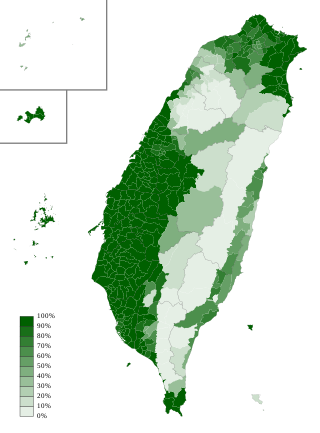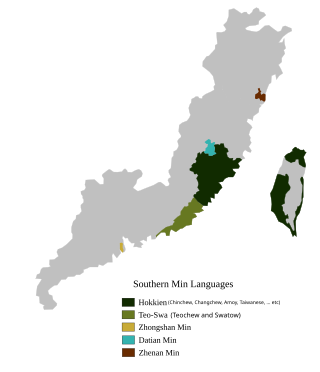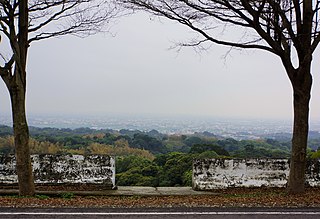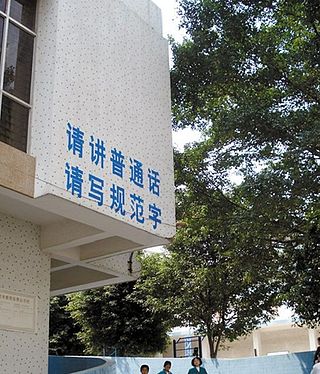
Taiwanese Hokkien, or simply Taiwanese, also known as Taiuanoe, Taigi, Taigu, Taiwanese Minnan, Hoklo and Holo, is a variety of the Hokkien language spoken natively by more than 70 percent of the population of Taiwan. It is spoken by a significant portion of those Taiwanese people who are descended from Hoklo immigrants of southern Fujian. It is one of the national languages of Taiwan.

Oden is a type of nabemono consisting of several ingredients such as boiled eggs, daikon or konjac, and processed fishcakes stewed in a light, soy-flavored dashi broth.

Southern Min, Minnan or Banlam, is a group of linguistically similar and historically related Chinese languages that form a branch of Min Chinese spoken in Fujian, most of Taiwan, Eastern Guangdong, Hainan, and Southern Zhejiang. Southern Min dialects are also spoken by descendants of emigrants from these areas in diaspora, most notably in Southeast Asia, such as Singapore, Malaysia, the Philippines, Indonesia, Brunei, Southern Thailand, Myanmar, Cambodia, Southern and Central Vietnam, San Francisco, Los Angeles and New York City. Minnan is the most widely-spoken branch of Min, with approximately 48 million speakers as of 2017–2018.
The National Languages Committee was established in 1928 by the Ministry of Education of the Republic of China with the purpose of standardizing and popularizing the usage of Standard Chinese in the Republic of China. The committee was known in English as the Mandarin Promotion Council or the National Languages Promotion Committee until 2003, but the Chinese name has not changed. The phrase Guoyu typically refers to Standard Chinese, but could also be interpreted as referring to "national languages". The reorganization of the Executive Yuan made the duties of the National Languages Committee be transferred to the Department of Lifelong Education's fourth sector from 2013.

Taiwanese Mandarin, frequently referred to as Guoyu or colloquially as Huayu, is the variety of Mandarin Chinese spoken in Taiwan. A large majority of the Taiwanese population is fluent in Mandarin, though many also speak a variety of Min Chinese known as Taiwanese Hokkien, commonly called Minnanyu, Southern Min, or Hokkien. This language has had a significant influence on Mandarin as spoken on the island.

The languages of Taiwan consist of several varieties of languages under the families of Austronesian languages and Sino-Tibetan languages. The Formosan languages, a geographically designated branch of Austronesian languages, have been spoken by the Taiwanese indigenous peoples for thousands of years. Owing to the wide internal variety of the Formosan languages, research on historical linguistics recognizes Taiwan as the Urheimat (homeland) of the whole Austronesian languages family. In the last 400 years, several waves of Han emigrations brought several different Sinitic languages into Taiwan. These languages include Taiwanese Hokkien, Hakka, and Mandarin, which have become the major languages spoken in present-day Taiwan.

Tongxiao Township is an urban township in southern Miaoli County, Taiwan. It lies between the Taiwan Strait on the west and mountains on the east.
Taiwanese units of measurement are the customary and traditional units of measure used in Taiwan. The Taiwanese units formed in the 1900s when Taiwan was under Japanese rule. The system mainly refers to Japanese system. The measurement refers to the traditional size of a Japanese flooring mat called a Tatami mat which were positioned to completely cover the floor of traditional Japanese homes, therefore it became a convenient measurement tool as mat area was standardised hundreds of years ago. In Taiwan the measurement units are pronounced in Taiwanese Hokkien and Hakka before the World War II and adopted by the Mandarin speaking immigrants from China in 1949. Today, the Taiwanese units are used exclusively, in some cases alongside official SI units, and in other cases they have been replaced by SI.

Hokkien is a variety of the Southern Min Chinese languages, native to and originating from the Minnan region, in the southeastern part of Fujian in southeastern mainland China. It is also referred to as Quanzhang, from the first characters of the urban centers of Quanzhou and Zhangzhou.

Houlong Township is an urban township in western Miaoli County, Taiwan. It is bordered by the Taiwan Strait on the west and Zaoqiao Township on the east. It lies at the mouth of the Houlong River. Miaoli HSR station is located in Houlong.

Huatan Township is a rural township in Changhua County, Taiwan.

The official romanization system for Taiwanese Hokkien in Taiwan is locally referred to as Tâi-uân Bân-lâm-gí Lô-má-jī Phing-im Hong-àn or Taiwan Minnanyu Luomazi Pinyin Fang'an, often shortened to Tâi-lô. It is derived from Pe̍h-ōe-jī and since 2006 has been one of the phonetic notation systems officially promoted by Taiwan's Ministry of Education. The system is used in the MoE's Dictionary of Frequently-Used Taiwan Minnan. It is nearly identical to Pe̍h-ōe-jī, apart from: using ts tsh instead of ch chh, using u instead of o in vowel combinations such as oa and oe, using i instead of e in eng and ek, using oo instead of o͘, and using nn instead of ⁿ.
Differing literary and colloquial readings for certain Chinese characters are a common feature of many Chinese varieties, and the reading distinctions for these linguistic doublets often typify a dialect group. Literary readings are usually used in loanwords, names, literary works, and in formal settings, while colloquial/vernacular readings are usually used in everyday vernacular speech.
Hokkien, a Southern Min variety of Chinese spoken in Southeastern China, Taiwan and Southeast Asia, does not have a unitary standardized writing system, in comparison with the well-developed written forms of Cantonese and Vernacular Chinese (Mandarin). In Taiwan, a standard for Written Hokkien has been developed by the Republic of China Ministry of Education including its Dictionary of Frequently-Used Taiwan Minnan, but there are a wide variety of different methods of writing in Vernacular Hokkien. Nevertheless, vernacular works written in Hokkien are still commonly seen in literature, film, performing arts and music.
Taiwanese Phonetic Symbols constitute a system of phonetic notation for the transcription of Taiwanese languages, especially Taiwanese Hokkien. The system was designed by Professor Chu Chao-hsiang, a member of the National Languages Committee in Taiwan, in 1946. The system is derived from Mandarin Phonetic Symbols by creating additional symbols for the sounds that do not appear in Mandarin phonology. It is one of the phonetic notation systems officially promoted by Taiwan's Ministry of Education.

Protection of the varieties of Chinese refers to efforts to protect the continued existence of the varieties of Chinese in Mainland China and other places against pressure to abandon these languages and use Standard Chinese. The Ministry of Education of the People's Republic of China has proclaimed to be taking active measures to protect ten varieties of Chinese. However, a large majority of the citizens of China speak a dialect of Mandarin Chinese, a standardized form of which has been enforced and promoted by the government of China for the last sixty years. The Constitution of the People's Republic of China calls on the government to promote Putonghua as the common tongue of the nation, but this policy has caused conflict to a certain extent with plans to preserve local varieties of Chinese. Education and media programming in varieties of Chinese other than Mandarin have been discouraged by the governments of the People's Republic of China, Singapore, and Taiwan. Teaching the varieties of Chinese to non-native speakers is discouraged by the laws of the People's Republic of China in favor of Putonghua. The Guangdong National Language Regulations are a set of laws enacted by the Guangdong provincial government in the People's Republic of China in 2012 to promote the use of Standard Mandarin Chinese in broadcast and print media at the expense of the local standard Cantonese and other related dialects. It has also been labelled a "pro-Mandarin, anti-Yue" legislation.

Khong bah png, as known as Braised pork rice, is a gaifan dish found in Fujianese cuisine and Taiwanese cuisine. Although subject to regional variations, dishes are typically made of pork belly cooked in a process known as lu and served on top of rice. Chinese pickles are often eaten with the dish.
The Dictionary of Frequently-Used Taiwan Minnan is a dictionary of Taiwanese Hokkien commissioned by the Ministry of Education of Taiwan. The dictionary uses the Taiwanese Romanization System to indicate pronunciations and includes audio files for many words. As of 2013, the dictionary included entries for 20,000 words.

Pokua, also Tshit-jī-á kua, is a kind of traditional folk music in Taiwan and Penghu which can be traced from Hokkein peoples that migrated to Taiwan under Qing ruled. The main themes found in Pokua songs include elements of romance, weather, the environment, festival activities and events of everyday life. Pokua has no fixed process of performance; people are able to sing Pokua with improvised lyrics or rhythms.














